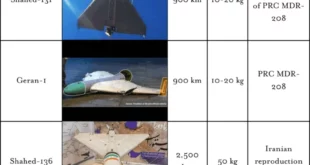Watching Russia falter in Ukraine, Chinese President Xi Jinping may conclude that if he decides to invade Taiwan, he cannot hope to achieve victory with little or limited fighting. The risk is that this will lead him to prepare a much bigger assault, deploying far heavier and more concentrated firepower to batter the island into submission.
In response to this possibility, a number of recent assessments have called for Taiwan to pursue an “asymmetric” dragon-choking “porcupine strategy” prioritizing “a large number of small things” for its defense. In short, turn the anti-access/area denial issue on its head and present People’s Liberation Army forces with multiple, numerous, hard-to-counter defenses that specifically target key Chinese military weaknesses. Drawing on Ukraine’s experience, there are eight concrete areas where the United States and Taiwan should now invest to make the island tougher to invade, even harder to subdue, and harder still to occupy and govern: ballistic missile defense, air defense, sea-denial fires, shore-denial fires, mine warfare, information warfare, civil defense, and the resilience of critical infrastructure.
The goal of these measures is to present a robust anti-access/area-denial threat to Beijing’s aspirations in Taiwan, clouding its prospects for military and political success and, ideally, keeping the threat of Chinese invasion hypothetical through this critical decade and beyond.
Ballistic Missile Defense
Dispersion, mobility, and hardening are critical to surviving and staying in the fight. Russia’s initial experiences in Ukraine will likely lead China’s military to conclude that attacking Taiwan would require deploying overwhelming fires up front, instead of holding back like Russia did initially. Ballistic missile defense is thus vital for calling into question the reliability of China’s missile might. Taiwan is scheduled to have its 350 American Patriot Advanced Capability-3 missiles upgraded through the life-extension program and seeks to purchase 300 additional interceptors. For protection against People’s Liberation Army Rocket Force short-range ballistic missiles, Taiwan also needs Terminal High-Altitude Area Defense on mobile units. Beyond the four MQ-9 high-altitude, long-endurance surveillance drones they are currently acquiring from the United States, Taiwanese forces should put GPS/Beidou jammers on additional unmanned air vehicles or, potentially, aerostats, parked at altitude to interfere with missile guidance systems and reduce Chinese ballistic missiles’ accuracy.
Passive hardening, dispersion, and decoys would also function as a form of ballistic missile defense, with at least three benefits. First, they would increase the number of missiles that China’s military must assign per target to achieve the same level of success. Second, they could help turn the math in Taiwan’s favor by forcing Beijing to fire additional expensive ballistic missiles against decoys and thicker concrete often costing several orders of magnitude less. Third, they would help to deplete Chinese missile stocks that could otherwise be fired at regional bases that U.S. forces would rely on to maintain high-sortie rates in response to an attack on Taiwan.
Air Defense
Ukraine’s experience demonstrates the importance of layered ground-based air defenses that, even if imperfect, can deny an attacker air control over key terrain. As Harry Halem and Eyck Freymann explain, “Without air control … China would be incapable of executing almost any military plan against Taiwan.”
For the longest-range, highest-altitude engagements, variants of the Patriot surface-to-air missile discussed above would capitalize upon Taiwanese forces’ existing familiarity with the platform. The missile’s predominantly American supply chain also makes it harder for China to deter or disrupt weapons transfers. At the medium-range level, the Norwegian Advanced Surface-to-Air Missile System platform could be ideal given its use of the combat-proven AIM-120 Advanced Medium Range Air-to-Air Missile, dispersion of fire control and launch assets, and wheeled mobility compatible with cave/tunnel-sheltered operations. The Advanced Medium Range Air-to-Air Missile-Extended Range now under development and the Evolved Sea Sparrow Missile family already in service offer the potential to expand engagement envelopes. For the same cost as Taiwan’s 2019 deal to acquire 66 F-16V fighters, the island’s military could purchase eight Patriot Advanced Capability-2 batteries (48 launchers and 192 missiles in-canister) or more than 150 Norwegian Advanced Surface-to-Air Missile System batteries. Smaller expenditures could procure hundreds of replacement missile rounds.
Finally, Taiwan should amass large stocks of man-portable air-defense systems, which have already shown their utility in Ukraine against aircraft with similar performance characteristics to many in China’s air force. As of early April, NATO countries have delivered or promised 25,000 “anti-air” weapons systems to Ukraine, most of them man-portable. Taiwan’s smaller size could mean fewer weapons biased toward higher capability, but the quantity transferred to Ukraine illustrates the sheer munitions mass likely to be required to sustain a high-end fight to contest airspace against a capable, determined invader. Beyond the FIM-92 Stinger missiles that the United States will deliver by 2026, additional man-portable systems should therefore be stockpiled in large numbers for Taiwan’s defense, together with flak traps, advanced infrared and/or mobile active radar surface-to-air missiles, and Surface-Launched Advanced Medium-Range Air-to-Air Missiles (like those from a five-missile carrier on the M1097 Humvee). Taiwanese forces could also likely make use of mobile anti-air guns such as tractor-bed-based Mk15 Block 1B Phalanx close-in weapons systems or even low-cost .50 caliber and 20mm weapons mounted in trucks “technical” style for anti-air and direct fire against ground forces.
Mine Warfare
Washington and Taipei should place greater emphasis on sea mines, whose capacity to deny freedom of movement to Chinese forces in waters near Taiwan and landing access in the surf zone has been insufficiently appreciated. Taiwanese planners already understand this, as evidenced by Drew Thompson’s commentary in these pages more than three years ago. But both the Taiwanese and U.S. militaries should accelerate these efforts.
Taiwan should now urgently build or acquire shallow-water mines akin to the Russian PDM series, which could be rapidly deployed in the tidal zone of likely landing points. Using cheap, rapidly deployable passive obstacles such as steel Czech hedgehogs and concrete Jersey barriers could help to channel incoming landing forces, thereby amplifying the mines’ lethality. Ukraine’s efforts in these areas may have helped to deter a Russian amphibious assault on Odessa, a lesson worth considering for Taiwan.
For its part, America should urgently stockpile Quickstrike-Extended Range standoff air-delivered mines at regional bases and in the continental United States. These underappreciated weapons can glide 40 nautical miles with precision in order to seal off maritime passages, including key landing approaches to Taiwan’s relatively few suitable beaches. Integrated with aircraft such as the B-2 or B-21, they could also be deployed from contested airspace. If necessary, they could also be deployed directly from the continental United States and arrive on target within 15–16 hours. Forward basing out of Northern Australia, Wake Island, or other locations beyond the range of most Chinese fires would potentially allow their deployment within 6–10 hours of takeoff.
Sea-Denial Fires
Taiwanese forces should pursue a three-layered approach to defending Taiwan’s coastline from amphibious attack. The outermost layer would involve munitions capable of striking Chinese staging areas and ports, as well as petroleum, oil, and lubricants tanks to disrupt an invasion force and potential follow-on waves. Taiwan has for more than a decade fielded a 600km-range land-attack cruise missile (the Hsiung Feng IIE) capable of such interdiction missions as well as an air-launched cruise missile (the Wan Chien) with a 240km-range, but only small numbers of rounds.
American assistance should thus be structured to rapidly augment existing Taiwanese indigenous systems and amplify their deterrent effect through the prospect of expanding them. Taiwan plans to double advanced missile production to a total of nearly 500 per year in 2022. But as Ukraine’s example shows, that may only amount to days of supply during a high-end war, making imported weapons an important component of pre-conflict preparation. In 2020, the United States approved the sale of 135 AGM-84H Standoff Land Attack Missile Expanded Response units to Taiwan for approximately $1 billion. These high-precision, 300km-range weapons are air-launched, combat-proven, carry an 800lb warhead, and offer Taipei the ability to interdict Chinese military support infrastructure and vessels in port.
To ensure second-strike capability, Taiwan likely needs several times its current inventory of these missiles, dispersed to highways and other forward-operating points that could survive a surprise ballistic and cruise missile strike by China. Taiwan should attempt to obtain Harop-type long-range loitering munitions as well. U.S. defense contractors could potentially produce the latter under license from Israeli Aircraft Industries to blunt potential Chinese pressure — sales of Spike missiles and other hardware to Taiwan could provide an incentive for the deal.
The second layer entails stockpiling and deploying anti-ship missiles and precision-guided munitions to deny China the ability to reach Taiwanese ports. Again, the intent would be for American-origin systems to amplify Taiwan’s indigenous capabilities, such as the 120–150km-ranged Hsiung Feng III supersonic anti-ship cruise missile. The United States has already approved the sale of 100 Harpoon land-based coastal defense cruise missile launchers, 400 missiles, and 25 associated radars to Taiwan. With a range of 124km, Harpoon Block II missiles could engage Chinese vessels soon after they leave port. If China begins posturing for an invasion, Washington should facilitate Taipei purchasing even more launchers and missile rounds, perhaps even through a lend-lease arrangement.
On April 13, 2022, two Ukrainian Neptune anti-ship cruise missiles struck the cruiser Moskva, Russia’s Black Sea flagship, causing it to catch fire and sink. Moskva’s sundering shows how coastal anti-ship cruise missiles can be hard to see coming in sufficient time to defend against if ships are operating close to land. Losses inflicted on the British Royal Navy by Argentine Exocet missiles during the Falklands War and the near-loss of USS Stark after two Exocet strikes in 1987 suggest that rapidly maximizing the quantity and survivability of Taiwan’s long-range anti-ship missile inventory could seriously challenge People’s Liberation Army Navy operations near the island.
Shore-Denial Fires
The third layer of coastline defense should rely on precision fires to turn Taiwan’s nearshore waters and beaches into kill zones. Taiwanese forces need multiple-launch rocket artillery with submunitions (for example High-Mobility Artillery Rocket Systems) to target any landing force close to Taiwan’s coast. Furthermore, the High-Mobility Artillery Rocket Systems platform could employ Saab’s Ground-Launched Small Diameter Bomb, whose 150km-range and high precision would allow rocket systems dispersed throughout Taiwan to target a Chinese landing force. The United States has already agreed to deliver at least 11 High-Mobility Artillery Rocket Systems by 2027 — a number that should be substantially increased to accommodate combat attrition and ensure sufficient mass of fire against a potential invasion attempt.
Taiwanese forces should also stockpile relatively high-volume, lower-cost precision-guided munitions to overwhelm invaders near or on its beaches. AGM-114 Ground-Launched Hellfire-Light missiles deployed in anti-ship mode from mobile platforms (such as a modified Humvee chassis) offer one option. This Littoral Combat Ship surface module concept could also be fitted to commercial fishing vessels to threaten and destroy small boats, such as amphibious assault craft.
The United States should also help Taiwan to acquire substantial numbers of Javelin missiles and additional advanced versions of the BGM-71 Tube-launched, Optically tracked, Wire-guided anti-tank missile, with rounds pre-positioned in hardened locations near likely landing areas. Ukraine’s fight thus far suggests that repelling an intense multi-vector invasion attempt can realistically require thousands of anti-armor munitions.
The war in Ukraine has already absorbed a significant portion of U.S. Javelin and Stinger stockpiles. This means supplying Taiwan would require investing in the American munitions industrial base to substantially increase production capacity. Incoming Undersecretary for Acquisition and Sustainment William LaPlante’s recent Senate confirmation hearing testimony suggests that such investments could be forthcoming soon. The White House and Congress should also consider license-manufacturing of certain systems in Taiwan to bolster domestic support on the island and allow U.S. plants to more rapidly replenish America’s own stocks.
Finally, Taiwan should also install North Korean-style tube artillery in tunnels bored into mountainsides, with pre-zeroed aim points for rapid firing on the key beaches near Taipei and Kaohsiung and just offshore. The most lethal combination would involve 155mm guided shells, such as the combat-proven Excalibur, and tunnel-based mobile gun platforms such as the M109 Paladin, already approved for sale to Taiwan, or the rapid-firing BAE/Bofors Archer.
Jamming, Decoys, and Deception
Aircraft should be protected through sensor denial, with radio frequency jamming pods as well as multi-platform-based jamming of satellite navigation and radio communications to insert confusion into China’s battle plan. Inflatable decoys of beach, surface-to-air missile, and coastal battery vehicles and radars should be deployed and moved frequently to undermine the Chinese military’s situational awareness. Decoys and actual vehicles should employ camouflage — multi-spectral camouflage for the real defensive equipment and less-capable concealment for the decoys. This could be amplified through the use of social media. Posting distant photos of camouflaged decoys on social media can add an air of authenticity and make the targets more attractive. Taiwan could also disguise actual armored vehicles as different types of civilian heavy equipment to complicate Chinese targeting efforts.
Lastly, decoys can serve more lethal purposes by distracting sensors and operators on target platforms like warships to open them up for other strikes. Ukrainian officials claim that they used Bayraktar TB2 drones in precisely this way to enable Neptune anti-ship missiles to strike and ultimately sink the Moskva. This suggests that Taiwanese forces could use aerial and aquatic “active decoy” drones to facilitate targeting against a blockading or invading fleet.
Civil Defense and Urban Warfare
Washington and Taipei should help to prepare the island for insurgency. In addition to Taiwan’s just-released Civil Defense Handbook and existing “territorial defense,” this should involve building stocks of shoulder-fired anti-armor weapons with soft launch for urban warfare. These could include Next Generation Light Anti-Tank Weapons and the Panzerfaust 3, together with indigenous Taiwanese production. It also makes sense to cache 5.56 NATO caliber assault weapons and 7.62 NATO/338 Lapua/.50 Browning Machine Gun-caliber sniper rifles, plus ample ammunition stocks. As the achievements of Ukrainian sharpshooters now wreaking havoc on Russian field leadership suggest, sniper training should be expanded immediately in Taiwan’s military. The United States can facilitate such training, and also transfer knowledge on the manufacture and employment of improvised explosive devices.
Life-Essential Infrastructure
Taiwan should prepare for the possibility of siege warfare by Chinese forces. Taiwan’s Petroleum Administration Law currently requires that the government hold petroleum stocks equivalent to 30 days of what consumption was during the prior year, meaning approximately one million barrels per day. It would be better to store 60 days of liquid fuel in hardened, buried, and dispersed locations.
Taiwan should prepare some emergency stockpiles at higher elevations and run buried pipelines to generators and fuel offtake risers downhill so that in the event of total power loss, fuel can be moved by gravity. Fuel suppliers should also practice “over-the-shore” fuel deliveries of the type used to resupply facilities in austere locations, in case ports normally used for fuel deliveries are denied or destroyed by Chinese strikes. Holding a much higher inventory level in a more dispersed fashion entails a significant investment (roughly $3.5 billion at today’s prices) but would reduce vulnerability to precision-guided munitions strikes and increase Taiwan’s ability to withstand a blockade.
Likewise, the experiences of Mariupol and other Ukrainian cities show that the combination of intense shelling and purposeful Russian siege tactics have cut civilians off from food and water supplies. Accordingly, 120 days of basic food stocks should be dispersed to ensure resilience against possible maritime blockade attempts. During the early phase of the COVID-19 pandemic, Taiwan’s Ministry of Economic Affairs estimated that local food and key goods stocks were sufficient for 1–3 months, an amount likely insufficient to weather a prolonged blockade. Every Taiwanese community of 5,000 or more people should have groundwater wells with hardened, high-resiliency backup power to maintain potable water supplies in case Chinese forces strike reservoirs and main aqueduct systems. As the recent Tonga volcanic eruption underscores, Starlink-type satellite internet receivers can also enable continued communication if Chinese attacks disrupt undersea cables.
To ensure basic electricity flow, critical to water supply and communications, multi-fuel turbine electrical power generators should be distributed and installed near fuel-storage locations. Fuel supplies for the generators should be dispersed — and, to the extent possible, tanks should be placed underground, in caves or in subsurface structures resistant to air and missile attack. Dispersion planning should assume that Chinese ballistic and land-attack cruise missiles can achieve circular error probable of 5–10 meters.
Conclusion
These eight measures arise from a vital lesson of the ongoing war in Ukraine: Each day that a smaller defender stays in the fight, the more constrained the invader’s options become and the dimmer its prospects for success. China seeks to win without fighting, or with minimal fighting. For Taiwan, the best path is trying to avoid the fight by ensuring that if it starts, it will last for months, be bloody, and prevent China from consolidating meaningful gains before American and allied firepower arrives. With rapidly deployable assistance, munitions, and training, Washington can help Taiwan to become a dragon-choking porcupine before it’s too late.
 Eurasia Press & News
Eurasia Press & News



